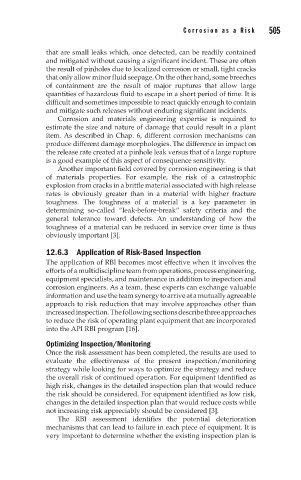Page 539 - Corrosion Engineering Principles and Practice
P. 539
504 C h a p t e r 1 2 C o r r o s i o n a s a R i s k 505
that are small leaks which, once detected, can be readily contained
and mitigated without causing a significant incident. These are often
the result of pinholes due to localized corrosion or small, tight cracks
that only allow minor fluid seepage. On the other hand, some breeches
of containment are the result of major ruptures that allow large
quantities of hazardous fluid to escape in a short period of time. It is
difficult and sometimes impossible to react quickly enough to contain
and mitigate such releases without enduring significant incidents.
Corrosion and materials engineering expertise is required to
estimate the size and nature of damage that could result in a plant
item. As described in Chap. 6, different corrosion mechanisms can
produce different damage morphologies. The difference in impact on
the release rate created at a pinhole leak versus that of a large rupture
is a good example of this aspect of consequence sensitivity.
Another important field covered by corrosion engineering is that
of materials properties. For example, the risk of a catastrophic
explosion from cracks in a brittle material associated with high release
rates is obviously greater than in a material with higher fracture
toughness. The toughness of a material is a key parameter in
determining so-called “leak-before-break” safety criteria and the
general tolerance toward defects. An understanding of how the
toughness of a material can be reduced in service over time is thus
obviously important [3].
12.6.3 Application of Risk-Based Inspection
The application of RBI becomes most effective when it involves the
efforts of a multidiscipline team from operations, process engineering,
equipment specialists, and maintenance in addition to inspection and
corrosion engineers. As a team, these experts can exchange valuable
information and use the team synergy to arrive at a mutually agreeable
approach to risk reduction that may involve approaches other than
increased inspection. The following sections describe three approaches
to reduce the risk of operating plant equipment that are incorporated
into the API RBI program [16].
Optimizing Inspection/Monitoring
Once the risk assessment has been completed, the results are used to
evaluate the effectiveness of the present inspection/monitoring
strategy while looking for ways to optimize the strategy and reduce
the overall risk of continued operation. For equipment identified as
high risk, changes in the detailed inspection plan that would reduce
the risk should be considered. For equipment identified as low risk,
changes in the detailed inspection plan that would reduce costs while
not increasing risk appreciably should be considered [3].
The RBI assessment identifies the potential deterioration
mechanisms that can lead to failure in each piece of equipment. It is
very important to determine whether the existing inspection plan is

